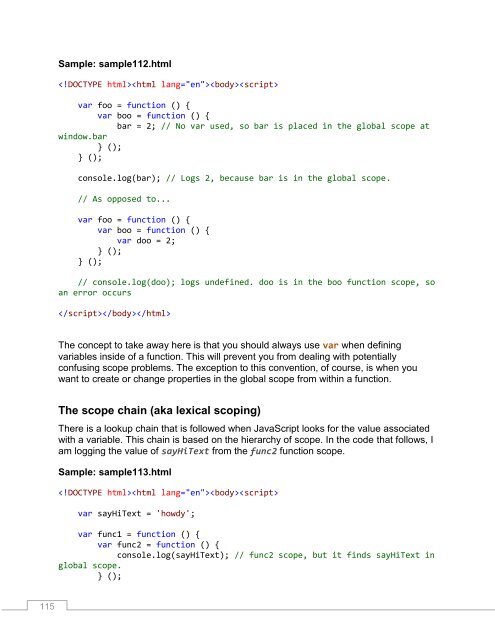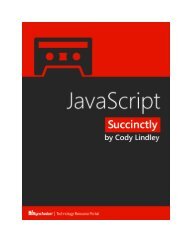JavaScript_Succinctly
Create successful ePaper yourself
Turn your PDF publications into a flip-book with our unique Google optimized e-Paper software.
Sample: sample112.html<br />
<br />
var foo = function () {<br />
var boo = function () {<br />
bar = 2; // No var used, so bar is placed in the global scope at<br />
window.bar<br />
} ();<br />
} ();<br />
console.log(bar); // Logs 2, because bar is in the global scope.<br />
// As opposed to...<br />
var foo = function () {<br />
var boo = function () {<br />
var doo = 2;<br />
} ();<br />
} ();<br />
// console.log(doo); logs undefined. doo is in the boo function scope, so<br />
an error occurs<br />
<br />
The concept to take away here is that you should always use var when defining<br />
variables inside of a function. This will prevent you from dealing with potentially<br />
confusing scope problems. The exception to this convention, of course, is when you<br />
want to create or change properties in the global scope from within a function.<br />
The scope chain (aka lexical scoping)<br />
There is a lookup chain that is followed when <strong>JavaScript</strong> looks for the value associated<br />
with a variable. This chain is based on the hierarchy of scope. In the code that follows, I<br />
am logging the value of sayHiText from the func2 function scope.<br />
Sample: sample113.html<br />
<br />
var sayHiText = 'howdy';<br />
var func1 = function () {<br />
var func2 = function () {<br />
console.log(sayHiText); // func2 scope, but it finds sayHiText in<br />
global scope.<br />
} ();<br />
115



